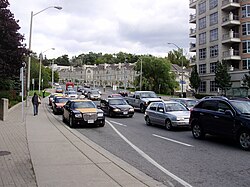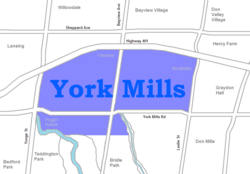York Mills
York Mills | |
|---|---|
Neighbourhood | |
 Traffic in York Mills, east of Yonge. | |
 | |
| Coordinates:43°44′35″N79°24′24″W/ 43.74306°N 79.40667°W | |
| Country | |
| Province | |
| City | Toronto |
| Municipality established | 1850York Township |
| Changed municipality | 1922North Yorkfrom York Township |
| Changed municipality | 1998Torontofrom North York |
| Government | |
| •MP | Rob Oliphant(Don Valley West) |
| •MPP | Stephanie Bowman(Don Valley West) |
| •Councillor | Jaye Robinson(Ward 25Don Valley West) |
York Millsis a neighbourhood inToronto,Ontario, Canada. It is centred aroundYonge StreetandYork Mills Roadlocated in the district ofNorth York.In 2010, it encompassed the fourth and seventh most affluent postal codes in Canada.[1]It is recognized as amillionaires' mile,alongside the other Toronto neighbourhoods ofThe Bridlepath,Forest Hill,andRosedale.
Part of the area is also known asHoggs Hollow,named for James Hogg, aScottishsettler who settled in the area in 1824 and operated the mill on Yonge Street at the Don River north of the Town of York (now Toronto), by his sons John and William in 1856. Another portion is named St. Andrew-Windfields. St. Andrew-Windfields most famous resident was the popular Canadian PhilanthropistE. P. Taylorwho left Canada towards the latter years of his life and donated Parkland (now Windfields Park) and his mansion (now theCanadian Film Centre).
History
[edit]The area name is linked tosawandgrist millsthat dotted theDon River,which flows through York Mills. The Town of York Mills became part of the Township ofNorth York.

The area once linked byradial railways(Metropolitan lineand the successorNorth Yonge Railways) andHighway 11,now can be reached viaHighway 401,GO Transit,andToronto Transit Commissionbuses andYork Millsstation on theYonge-University Spadina subway line.
In 1953, York Mills, along with North York, was severed fromYork County,joining other municipalities to form the regional government ofMetropolitan Toronto.The area was the site of a tragic accident on March 17, 1960, when five Italian construction workers on awater mainproject were killed in a tunnel fire. North York later became a borough, and then a city, and was merged with five other municipalities and a regional government to form the new "City of Toronto" in 1998.
Today, the area is home to luxury condos and high-end homes. Houses in York Mills are highly distinguishable and contribute greatly to the proclaimed affluence of the neighbourhood. 50% of occupied dwellings are single detached houses. Many have been rebuilt and customized to taste, with heavily renovated front yards. In between 2001 and 2006, property values have increased by 47.6%.[2]The second type of most occupied dwelling is apartments reaching five or more storeys, inhabited by 28% of the population.[3]The average price for condominiums in the area ranges from C$800,000 to C$3,000,000, while the average price of a detached home is just above C$4,000,000.[4][5]
St. Andrew's Golf Course
[edit]From 1927 to 1950s the area south of Highway 401 and east of Yonge Street was home to St. Andrew's Golf Course. Designed byStanley Thompsonas an 18-hole course and later as 27 hole course,[6]it was sold to developers and now a residential area centred at Old Yonge Street and the Links Road.[7]The course hosted theCanadian Openin 1935 and 1936.[8]
Geography
[edit]
From Yonge Street eastward, the roads slope upward but plateau as they reach Bayview Avenue. The natural environment is also highly integrated into the neighbourhood, with development seeming to build around it. The presence of greenery is a protected and distinguishable feature of York Mills.
Man-made environment
[edit]South of York Mills Road and Yonge Street sits the sub-neighbourhood ofHoggs Hollow.Houses in this residential area are embedded into the natural landscape, which ascends southward. The directional slope and other natural features serve as identifiable landmarks, edges, and paths, making this area highly legible in terms of aLynchiananalysis. The area has more community-oriented characteristics that make it distinct from the rest of York Mills. Most notably, residents manage a community board located in the centre of this sub-neighbourhood.

As York Mills is a mainly residential neighbourhood, commercial activity occurs strictly at intersections of major arterials. At Yonge Street and York Mills Road, the tallest commercial building in the neighbourhood,York Mills Centre,holds large office and retail spaces, occupied most notably by the human resources services supplier,Randstad Interim.The York Mills Shopping Centre at the intersection of York Mills Road and Bayview Avenue, provides local groceries through the Metro supermarket, Shoppers Drug Mart, and local meat shop. It is set back from the roads by a large parking lot, consistent with the neighbourhoods dependency on automobiles.
Along York Mills Road in between major intersections, there are only single detached houses. The pedestrian paths are very close to roads. Residential area here leaves no space for any commercial opportunities, thus commercial nodes are only available at the intersection of major arterial roads.
There is very little public space. Properly maintained parks are often playgrounds for children. Actual parks do not properly serve the public as well with its lack of seating and walkways, which discourages overall usage. Free parking compared to the high hourly rates of the rest of Toronto points to space in York Mills as being an inexpensive commodity, yet there is very little space actually available for development. The current Official Plan does not provide for the anticipation of future development.[9]
Landmarks
[edit]
Points of interest in York Mills:
- George S. Pratt House
- Miller Tavern
- St. John's Anglican Church
- William and Elizabeth Harrison House
- Windfields Park
Education
[edit]Twopublicschool boardsoperate schools in York Mills, the English-first languageToronto District School Board(TDSB), and the French-first languageConseil scolaire Viamonde(CSV).

TDSB also operates onesecondary schoolin the neighbourhood,York Mills Collegiate Institute.
TDSB also operate six schools that provideprimary education.They include:
- Dunlace Public School
- Harrison Public School
- Owen Public School
- St. Andrew's Middle School
- Windfield Middle School
CSV operates one secondary school in the neighbourhood,École secondaire Étienne-Brûlé.They do not operate an elementary school in the neighbourhood, with CSV elementary students residing in York Mills, attending schools in other neighbourhood.
Theseparate schoolboards for the City of Toronto, the English-basedToronto Catholic District School Board(TCDSB), and the French-basedConseil scolaire catholique MonAvenir(CSCM) also offer schooling to residents of York Mills, although they do not operate a school in the neighbourhood, with CSCM/TCDSB students attending schools situated in other neighbourhoods in Toronto.
Transportation
[edit]
As a result of the man-made environment, large lots, and sprawled out nodes of commercial activity, the neighbourhood is highly reliant on the automobile for everyday activities, with approximately two thirds of the York Mills population using it as a primary mode of transportation. Having Highway 401 in such close proximity adds to the benefits of owning a car, as the degree of mobility to the rest of Toronto greatly increases. Public transit is reported to be less than a quarter of the population's primary method of commute.[10]
Deeper in the residential areas, pedestrian walkways are often only found on one side of the road. As much of the land surrounding the major arterials are claimed by private residences, there is no room to develop along pedestrian paths and make walking a more appealing option. The combined effect of this lack of appeal, poor infrastructural maintenance, and extended distance in between points of interests justify the populations' avoidance of walking, with a mere three percent of the population claim walking as their primary mode of commute.[11]York Mills is an example of a neighbourhood stuck within the cycle of auto-dependency.[citation needed]
Public transportationis provided by theToronto Transit Commission(TTC). Services provided TTC includeLine 1 Yonge–Universityof theToronto subway,and severalbus routes.The TTC operates one subway station in the neighbourhood,York Mills station.Oriole GO Stationis also situated in the northeast of the neighbourhood, providing access toGO Transit's regional commuter railway.
References
[edit]- ^Canada's Richest Postal Codes"Richest Postal Codes 2011 | CanadianBusiness.com".Archived fromthe originalon November 27, 2012.RetrievedNovember 17,2012.
- ^Statistics Canada Census, 2006
- ^Statistics Canada Census, 2006
- ^Toronto Neighbourhood Guide."Toronto Neighbourhoods Real Estate Update 2012 - North York".Maple Tree Publishing.Retrieved9 October2013.
- ^Toronto Neighbourhood Guide."Homes in York Mills".Maple Tree Publishing.Retrieved9 October2013.
- ^"St. Andrews Golf Club — Stanley Thompson Society".
- ^"St. Andrews Golf Course".
- ^"St. Andrews Estates and Golf Course, York Mills, Ontario by J.I.B. Jones"(PDF).www.golfhistoricalsociety.org.
- ^"Toronto Official Plan"
- ^Statistics Canada Census, 2006
- ^Statistics Canada Census, 2006
External links
[edit]![]() Media related toYork Millsat Wikimedia Commons
Media related toYork Millsat Wikimedia Commons
